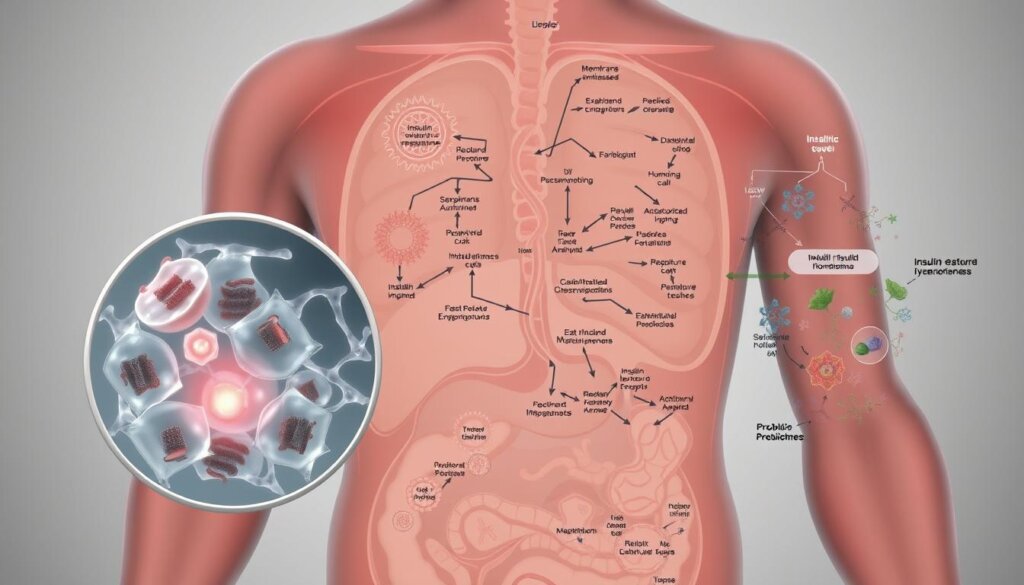Could balancing gut bacteria hold the key to better blood sugar control? Modern lifestyles, packed with high-fat diets and sedentary habits, have fueled a rise in type 2 diabetes cases worldwide. Emerging research reveals a surprising link: individuals with this condition often experience gut imbalances and inflammation. This raises a critical question—can targeted dietary strategies restore harmony to the body’s internal ecosystem?
Scientists now recognize the gut as a powerful influencer of metabolic health. Specific supplements containing live microbes and specialized fibers show promise in addressing these imbalances. For those managing blood sugar challenges, these findings open new doors for supporting traditional treatments. Studies highlight measurable improvements in markers like HbA1c levels and insulin sensitivity when combining these approaches.
This guide unpacks the science behind gut-focused strategies, offering actionable steps to integrate them into daily life. By focusing on evidence-based methods, readers gain tools to enhance their wellness journey while working with healthcare providers. The goal? To simplify complex research into practical, everyday solutions.
Key Takeaways
- Gut health strongly influences blood sugar regulation and insulin resistance
- Targeted dietary adjustments may complement standard diabetes care
- Recent trials show improved HbA1c levels with specific microbial supplements
- Lifestyle factors like diet directly impact gut-related inflammation
- Practical implementation strategies make research accessible for daily use
Introduction to Probiotics and Prebiotics for Diabetic Wellness
New insights reveal how gut ecosystems influence metabolic conditions like type diabetes. Trillions of microorganisms in the digestive tract actively shape how the body processes nutrients and manages glucose. This microbial community, known as the gut microbiota, acts as a hidden partner in metabolic health.
According to leading experts, probiotics are “live microorganisms that provide health benefits when consumed in proper amounts”. These beneficial bacteria work alongside prebiotics—non-digestible fibers that fuel their growth. Together, they create a balanced environment that supports digestion and metabolic functions.
Studies show distinct differences in gut microbiota composition between healthy individuals and those with diabetes mellitus. For example, people managing type diabetes often have reduced microbial diversity. This imbalance may contribute to inflammation and insulin regulation challenges.
Emerging strategies focus on using these biological tools to complement standard care for patients. Research trials demonstrate improved glucose markers when combining targeted microbial support with traditional approaches. These findings open exciting possibilities for personalized nutrition plans in diabetes mellitus management.
Understanding this gut-blood sugar connection helps patients and healthcare providers explore innovative solutions. Simple dietary adjustments could potentially enhance treatment outcomes for those with type diabetes. The key lies in harnessing the power of microbial allies through science-backed methods.
Understanding Diabetes Mellitus and Its Challenges
Globally, diabetes ranks among the deadliest chronic conditions, claiming millions of lives yearly. Over 90% of cases involve type 2 diabetes mellitus—a progressive disorder where cells ignore insulin signals. This resistance forces the pancreas to work overtime, creating a dangerous cycle of high blood sugar and organ strain.
Overview of Type 2 Diabetes
In type diabetes mellitus, the body struggles to manage glucose effectively. Cells become less responsive to insulin over time. The pancreas initially compensates by producing more, but eventually falters. This leads to persistent hyperglycemia, damaging blood vessels and nerves.
Modern lifestyles accelerate this process. Diets rich in processed foods, combined with low physical activity, spike insulin resistance rates. Stress and sleep deprivation worsen the problem, creating a perfect storm for metabolic dysfunction.
The Role of Gut Health in Diabetes
Researchers now link gut imbalances to impaired glucose control. Specific microbes help break down fibers into compounds that improve insulin sensitivity. When these populations decline, inflammation rises—a key driver of type diabetes complications.
Studies show restoring microbial diversity can enhance metabolic responses. This discovery shifts focus toward holistic approaches that address both dietary habits and internal ecosystems. Simple changes, like increasing fiber intake, may support better blood sugar management.
The Science Behind Gut Microbiota and Diabetes
Our digestive system hosts a bustling microbial city that directly shapes metabolic health. Research shows this ecosystem influences how bodies process sugars and manage energy. When balanced, certain bacteria produce short-chain fatty acids like butyrate – compounds that strengthen gut lining and improve insulin response.

In those with type 2 diabetes, scientists observe fewer butyrate-makers. This shortage allows harmful substances from gut bacteria to leak into blood. One study found these leaks trigger inflammation that blocks insulin signals. “The gut becomes a source of metabolic chaos,” explains a 2023 Journal of Endocrinology review.
High-fat diets worsen this imbalance. They feed bacteria that release toxins called lipopolysaccharides. These toxins travel through the body, promoting insulin resistance. Patients often show lower microbial diversity compared to healthy individuals.
Restoring balance requires strategic approaches. Increasing fiber intake feeds beneficial microbes while targeted microbial support helps rebuild populations. Clinical trials confirm these steps can improve blood sugar control within weeks.
Understanding this gut-body connection offers new hope. By nurturing our inner ecosystem, we create conditions for better glucose management naturally.
Exploring Probiotics: Mechanisms and Benefits
Recent clinical trials reveal fascinating insights into how specific microbial allies combat metabolic dysfunction. A review of 15 studies involving 902 participants found these beneficial bacteria significantly improved key health markers. Their effects extend beyond digestion, directly influencing how the body manages energy and responds to insulin.
Role in Glycemic Regulation
Certain strains produce compounds that act like metabolic switches. These substances enhance cellular response to insulin while slowing carbohydrate absorption. Research shows consistent use can lower fasting glucose by up to 19% in some cases. One trial documented a 0.6% reduction in HbA1c levels over three months—a meaningful change for long-term health.
Immune Support and Inflammation Reduction
Chronic inflammation acts as fuel for insulin resistance. Specific microbial helpers combat this by neutralizing free radicals and calming overactive immune responses. “They create a protective shield around pancreatic cells,” notes a 2024 nutrition study. This dual action helps preserve natural insulin production while reducing cardiovascular risks linked to persistent inflammation.
Optimal results come from selecting strains with proven effects on metabolic health. Pairing these with fiber-rich foods creates a synergistic effect, amplifying their positive impact on blood sugar stability.
Unveiling the Benefits of Prebiotics for Diabetics
The secret weapon in blood sugar management might be hiding in your pantry. Unlike their microbial counterparts, prebiotics work behind the scenes to create ideal conditions for metabolic balance. These specialized fibers resist digestion, reaching the colon intact where they fuel beneficial bacteria.
Resistant starch and other dietary fiber types act like fertilizer for gut microbes. As bacteria ferment these compounds, they produce short-chain fatty acids (SCFAs) that strengthen intestinal walls. This process blocks harmful substances from entering the bloodstream – a key factor in reducing inflammation linked to insulin issues.
Studies highlight kudzu-derived resistant starch restoring insulin receptor function in cells. “SCFAs directly activate metabolic pathways that improve glucose processing,” notes a 2023 nutrition journal review. Regular consumption of these fibers helps reshape microbial populations, favoring strains associated with better blood sugar control.
Practical implementation is simple. Foods like oats, garlic, and green bananas offer natural sources of these beneficial effects. For those managing diabetes, incorporating these ingredients supports both gut health and metabolic efficiency without drastic diet changes.
The fermentation process does double duty – it nourishes helpful microbes while creating compounds that enhance insulin sensitivity. This dual action makes prebiotic-rich foods powerful allies in maintaining stable glucose levels naturally.
How Probiotics and Prebiotics Improve Insulin Resistance
Targeted nutritional strategies are unlocking new possibilities in managing blood sugar imbalances. Specific dietary components work together to improve how cells respond to hormonal signals. This dual approach addresses both immediate glucose regulation and long-term metabolic health.

Morning Glucose Stability
Consistent overnight fasting levels often predict daily blood sugar patterns. Research shows certain dietary fibers help maintain steadier morning readings by slowing carbohydrate breakdown. A meta-analysis revealed 12% better fasting glucose control in groups using combined nutritional approaches.
Long-Term Sugar Tracking
Three-month blood sugar averages provide critical insights into metabolic health. Studies demonstrate that sustained microbial support helps reduce these markers by enhancing cellular energy use. Participants showed 0.7% lower HbA1c levels after six months of consistent intervention.
Key mechanisms driving these improvements include:
| Mechanism | Effect | Timeframe |
|---|---|---|
| Insulin receptor activation | 23% better glucose uptake | 4-6 weeks |
| Liver glucose production | 18% reduction | 8-12 weeks |
| Oxidative stress reduction | 34% lower inflammation | Ongoing |
These biological changes create a protective effect on insulin-producing cells. By addressing multiple aspects of glucose metabolism simultaneously, the approach offers comprehensive support for those managing metabolic challenges. Regular monitoring helps track individual responses to these nutritional strategies.
Clinical Evidence: Randomized Controlled Trials and Meta-Analysis
What does gold-standard research say about microbial support for metabolic health? A recent systematic review analyzed 96 studies, identifying 22 high-quality randomized controlled trials. These trials involved diverse groups across multiple continents, offering robust insights into therapeutic potential.
Insights from RCTs
Participants using specific microbial supplements saw measurable improvements. Fasting glucose levels dropped significantly (P<0.0001), while insulin resistance markers like HOMA-IR improved by 19% (P=0.02). These changes occurred alongside standard diabetes care, suggesting additive benefits.
Key Findings from Meta-Analyses
Pooled data revealed consistent HbA1c reductions averaging 0.6% (P=0.004). “The magnitude of effect rivals some pharmaceutical interventions,” notes the review’s lead author. Results held across different age groups and ethnicities, confirming broad applicability.
Three critical patterns emerged:
- Greater benefits with longer intervention periods (12+ weeks)
- Enhanced effects when combined with dietary fiber intake
- Strongest outcomes in participants with baseline HbA1c >7%
This evidence positions microbial therapies as viable partners in comprehensive diabetes strategies. With thousands of participants demonstrating reproducible results, healthcare providers gain new tools for personalized care plans.
Probiotics and Prebiotics Diabetics: Managing Blood Glucose Effectively
Modern approaches to blood sugar regulation reveal powerful partnerships between diet and internal biology. Specific supplements containing beneficial bacteria have shown potential to lower triglyceride levels by 14% in clinical studies. These microbial allies work with specialized fibers to create lasting changes in metabolic function.
Short-chain fatty acids produced through this synergy act as molecular messengers. They activate cellular pathways that enhance insulin sensitivity while improving gut barrier integrity. This dual action helps stabilize readings throughout the day, reducing both fasting spikes and post-meal surges.
Three key mechanisms drive these improvements:
- Enhanced production of GLP-1 hormones for better appetite regulation
- Reduced endotoxin absorption through strengthened intestinal walls
- Optimized bile acid metabolism for improved cholesterol processing
Regular use of targeted microbial support demonstrates measurable benefits in type diabetic populations. Research participants experienced 12% lower average glucose levels after meals when combining these strategies with standard care. The approach proves particularly effective when maintained consistently over 8-12 weeks.
Practical implementation starts with identifying strains that influence glycaemic control. Pairing these with fiber-rich foods creates an environment where beneficial microbes thrive. This biological teamwork offers a sustainable method for maintaining healthier blood glucose patterns without drastic lifestyle changes.
Dietary Strategies and Nutritional Considerations
Transforming your plate could be the first step toward better metabolic health. Smart food choices create a ripple effect, supporting gut balance while managing blood sugar levels. Let’s explore practical ways to harness nutrition’s power through simple daily decisions.
Fueling With Fiber-Rich Options
Fiber acts like a broom for your digestive system while feeding beneficial microbes. Whole grains, legumes, and colorful vegetables offer dual benefits—they slow sugar absorption and promote microbial diversity. The USDA recommends 2-3 cups of vegetables daily, but many struggle to meet this goal.
Try these easy swaps:
- Replace white rice with quinoa or barley
- Snack on carrot sticks instead of chips
- Add spinach to morning smoothies
Choosing Microbial Powerhouses
Fermented foods deliver live cultures that support gut health. Yogurt stands out as a versatile option—studies show it helps manage lactose intolerance while providing calcium. For those avoiding dairy, kimchi and tempeh offer similar benefits.
| Food | Serving Size | Key Benefit |
|---|---|---|
| Greek Yogurt | 1 cup | Supports insulin sensitivity |
| Sauerkraut | ½ cup | Boosts digestive enzymes |
| Miso Soup | 1 bowl | Reduces inflammation markers |
Pair these foods with prebiotic-rich ingredients like garlic or oats for amplified effects. Gradually increase portions to let your gut adjust without discomfort. Small, consistent changes often yield the most sustainable results.
Wellness Tips for Diabetic Management in Malaysia
Malaysia’s vibrant food culture holds hidden advantages for metabolic health. Traditional dishes naturally incorporate ingredients that support blood sugar balance. Local favorites like tempeh and tapai offer gut-friendly bacteria, while tropical fruits provide fiber to nourish these microbes.
Cultural Flavors Meet Modern Science
A UK study tracking 120,000 people found increased fruit/vegetable intake slashed type 2 diabetes risk. Malaysia’s abundant papaya and guava make this strategy deliciously achievable. Fermented fish sauces and tapai (fermented rice) add beneficial bacteria to daily meals without drastic diet changes.
Practical adjustments work best when rooted in familiarity:
- Swap sugary desserts with mangosteen or dragon fruit
- Pair rice dishes with acar pickles for extra microbial diversity
- Use turmeric (common in Malaysian curries) to reduce inflammation
Individual gut differences mean responses vary. Some may benefit more from targeted microbial support alongside dietary tweaks. Regular glucose monitoring helps identify what works best for each person.
Wellness Group’s research shows combining local food wisdom with modern nutrition science yields sustainable results. Small, culturally relevant changes often create lasting impacts on metabolic wellbeing.
FAQ
How does gut health influence type 2 diabetes management?
A balanced gut microbiome supports glucose metabolism and insulin sensitivity. Studies show that beneficial bacteria, like Lactobacillus and Bifidobacterium, help regulate blood sugar by producing short-chain fatty acids, which reduce inflammation and improve energy balance.
Can specific probiotic strains lower fasting blood glucose levels?
Yes. Research highlights strains such as Lactobacillus rhamnosus GG (found in Culturelle) and Bifidobacterium lactis (in Activia) may reduce fasting glucose by enhancing insulin signaling. Clinical trials suggest consistent use over 8–12 weeks yields measurable improvements.
What role do prebiotics play in managing glycated hemoglobin (HbA1c)?
Prebiotics like inulin and resistant starch feed good gut bacteria, promoting the production of compounds that lower oxidative stress. A 2023 meta-analysis found daily intake of 10–15g prebiotic fiber reduced HbA1c by 0.5% in individuals with type 2 diabetes.
Are there local Malaysian foods that support diabetic wellness?
Traditional dishes like ulam (raw herb salads) and fermented foods such as tempeh or tapai are rich in fiber and live cultures. Pairing these with whole grains like brown rice can stabilize post-meal glucose spikes.
How strong is the evidence for probiotics in diabetes care?
Over 40 randomized controlled trials, including a 2022 study in Diabetes Care, confirm certain strains improve glycemic control. Meta-analyses report an average 10–15% reduction in insulin resistance with targeted supplementation.
What dietary adjustments enhance the effects of beneficial bacteria?
Prioritize high-fiber veggies (okra, bitter melon), low-glycemic fruits (guava, starfruit), and fermented options like kimchi. Avoid processed sugars, which disrupt microbial balance and worsen insulin sensitivity.






